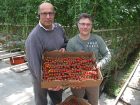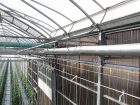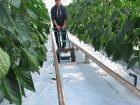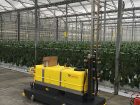
Features
Business
Research
Harrow research update: ‘It’s a total team approach’
Year-round production is just one of the many initiatives now underway at North America’s largest greenhouse vegetable research centre.
May 30, 2017 By Dave Harrison
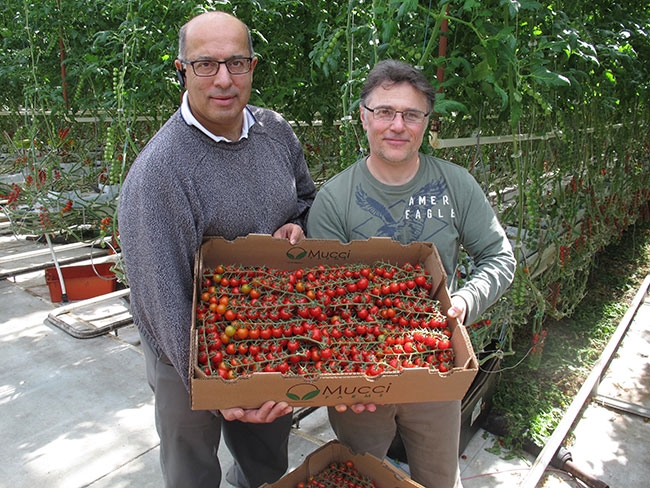 Shalin Khosla with tomato grower Fabio Ingratta of Mucci Farms and a winter crop grown with supplemental lighting. Very impressive results, says Ingratta.
Shalin Khosla with tomato grower Fabio Ingratta of Mucci Farms and a winter crop grown with supplemental lighting. Very impressive results, says Ingratta. June 2017 – Ontario’s greenhouse vegetable sector is maintaining its commitment to leading edge innovation and automation.
On the world stage, it’s definitely a star performer.
It’s always an eye-opener to visit the Leamington/Kingsville region and view the pace of new construction. I’ve been making the trek from our Simcoe, Ontario, offices for more than two decades, and there have always been construction crews shuttling around the region during each visit.
You’d be hard-pressed today to find a concession in the region that doesn’t have dust swirls from the movement of construction equipment and crews.
But equally impressive is what’s going on within the structures – the endless trials of new varieties and new crops, the highly automated packing lines, the advancements in lighting strategies for year-round production, and the advances in pest management.
It’s no coincidence that this level of growth and innovation is going on within a 30-minute or so drive of North America’s largest greenhouse vegetable research facility – the Harrow Research and Development Centre.
It’s interesting to note the sprawling Harrow complex is itself welcoming investment this year with construction of a new greenhouse. Completion is expected this fall, and it will be immediately put to good use – there’s never any shortage of research ideas for the scientists there to tackle.
Harrow researchers work closely with the Ontario Greenhouse Vegetable Growers association in identifying major challenges and opportunities. Projects are not confined to the high-tech facilities at Harrow but also to commercial greenhouses in the area.
The Harrow team is a mix of Agriculture and Agri-Food Canada scientists and technicians, along with research/extension specialists with the Ontario Ministry of Agriculture, Food and Rural Affairs.
DR. XIUMING HAO
Greenhouse vegetables are increasingly becoming a year-round brand in Canada, and much of the science behind this trend is being carried out at Harrow.
- The winter crop study is a comprehensive five-year project sponsored by the Ontario Greenhouse Vegetable Growers, Agriculture and Agri-Food Canada and the AgriInnovation program of Growing Forward 2. The project will conclude in 2018.
- A new project, specifically focusing on LED lighting, was also funded by Agriculture and Agri-Food Canada.
Dr. Xiuming Hao is leading the projects that involve AAFC colleagues at Harrow, Guelph and London research centres; the University of Guelph; and OMAFRA specialists.
Lighting is making it all possible, and the research has to account for all the variables associated with lit crops. They’re looking at the complete package, including nutrition, pest and disease management, and energy efficiency issues, among others.
Year-round market demand for locally grown vegetables: The market is asking for locally grown, consistent quality, premium brand produce year-round. Winter prices tend to be a little higher, and retailers prefer to work with a single supplier, rather than having to look to other suppliers in the winter – and that’s all good news for growers.
The current projects are building on work from earlier studies on crop lighting, including:
- From 2004 to 2008, the focus was on year-round production of cucumbers – long English and mini. Using HPS lighting, annual cucumber yields were increased by 100 to 150 per cent in comparison to unlit crops.
- And then from 2009 to 2013, researchers turned their attention to hybrid lighting systems – overhead HPS and intra-canopy LEDs – in a vertical lighting strategy with tomatoes. Roughly 60 per cent of the lighting was on top, with LEDs supplying the remainder within the canopy.
Supplemental lighting of tomatoes by itself can be too much of a good thing – the plants are sensitive to extended photoperiods, often leading to leaf chlorosis problems if the plant is pushed beyond its limit.
Dynamic Temperature Integration: Hao’s group came up with Dynamic Temperature Integration (TI) strategies. This involves a pre-night temperature drop of a half hour to two hours or so. The larger surface area of the leaves means they will cool faster than the fruit. This redirects the plant growth balance more towards the fruit for higher yields. It also means less chance of leaf chlorosis.
It’s important that the 24-hour temperature setting is maintained by incorporating slightly higher daytime temperatures.
The other benefit is that the lower evening temperatures also mean energy savings, especially within greenhouses that don’t have energy curtains. “With
energy curtains,” Hao explains, “the savings aren’t as great.”
Next up were mini-cucumbers. Thanks to improved micro-climate management and optimization of lighting, they have been able to extend the lifespan of the crop from three to six months. Just as impressive, there has been no need for pest sprays during trials the past two years.
With a conventional system, four crops are grown each year, with yields of about 15 kgs/sq/m per crop.
However with lighting, they grew a single winter crop from October to March achieving yields of about 60 kgs/sq/m. Adding a summer crop, then, would mean a doubling of the normal year-round yields with conventional crops. There would also be considerable savings on transplants and labour.
The team then looked at peppers last year, and again achieved impressive results. The key was cultivar selection – some respond well to lighting, while others do not.
The crop was planted in October and was finished in mid-April. Yields of 20 to 21 kgs/sq/m were recorded in the best treatment, and the trial was only terminated because the plants had outgrown the height of the greenhouse. Given a taller structure, the crop could have kept producing through to the end of August.
Normally, in a regular commercial greenhouse, full-year production yields of 25 to 28 kgs/sq/m are achieved.
Hao is looking forward to the fall and the completion of Harrow’s newest greenhouse that will be seven metres to the gutter, and able to accommodate the growth of the lit pepper crop. “This new greenhouse will allow us to finish the pepper trial and have a full year with the crop. But the early results are very promising.”
The new greenhouse will also feature anti-reflection coating on both sides of its diffused glass.
The Dynamic Temperature Integration (TI) strategies were also applied to the pepper trial, and with excellent results. Despite the longer photoperiod, there was very little leaf chlorosis. It also improved yields in March and April.
TI is now being applied to cucumber crops – long English and minis.
Far-red LED Light: Work is also continuing on work with Far-red LED Light. Under HPS lighting, leaves tend to be small and compact. A lot of the light ends up on the floor and is not intercepted by the leaves. The more light that is intercepted by the canopy, the better the rate of whole plant photosynthesis.
There is a solution. A small dose of Far-red light on the top of the crop will make the leaves and canopy bigger because the plants think they are being shaded. They will stretch and the leaves will grow larger to intercept more light, resulting in faster early growth and a high early yield.
“And you only need a small dose,” Hao explains.
The treatment has worked well on tomatoes. Trials last year with cucumbers were not as impressive, but that’s because the plants grow so fast.
This year the team is turning its attention to sweet peppers. Being a slower growing crop, much like tomatoes, the plants were quite compact under HPS, so the expectation is that the sweet pepper trials will achieve similar results as seen with tomatoes.
Vertical distribution light recipes: In the LED lighting study funded by Agriculture and Agri-Food Canada, Hao is working with colleagues at several centres and looking at vertical distribution light recipes for all three major crops.
“With LEDs you have a very narrow light spectrum,” says Hao. “You can change the light composition recipe.”
Considerable LED work has been done with leaf vegetable crops, such as lettuce and basil, but not as much with the larger fruiting vegetable crops, such as tomatoes, cucumbers and peppers.
LED lighting will improve leaf growth, and with crops such as lettuce and basil, that’s what you want. However, with tomatoes, cucumbers and peppers, researchers want to see the benefits also in the fruit. “We want to have good leaf growth and photosynthesis,” says Hao, “but we also want good fruit quality and improved yields.”
The vertical light distribution profile can be optimized by LEDs. Earlier studies looked at the intensity of light distribution, but now they’ll now also be looking at the light spectrum distribution. “Within the crop,” notes Hao, “the requirements for leaf growth and canopy growth will be different than the requirements for fruit growth.” Each will require a different light spectrum.
For example, you can increase the anti-oxidant content of cucumbers by applying blue LED light to the fruit.
“You want to have the optimal vertical light distribution with the proper light recipe. You want light that is good for leaf growth to produce high yields, and light that is good for fruit growth with high nutritional value and better fruit quality.
- Dr. Rong Cao of the Guelph Research and Development Centre of AAFC is a food anti-oxidant specialist. He will be looking at light recipes to improve the anti-oxidant content of tomatoes, cucumbers and sweet peppers.
- Prof. Bernie Grodzinski of the University of Guelph and graduate student Jason Lanoue are studying how LEDs can improve the translocation of photo-assimilates from the leaves to the fruit to increase yields.
- Dr. Aiming Wang of the London Research Centre of AAFC is looking at how light recipes can improve virus resistance.
- Harrow colleagues Dr. Rose Labbé (pest management) and Dr. Geneviève Marchand (plant diseases) of AAFC, and OMAFRA extension specialists Shalin Khosla (crop specialist) and Cara McCreary (pest management) are other key researchers on the projects.
“It’s a total team approach,” says Hao.
DR. ROSE LABBÉ
More and more greenhouse vegetable growers are moving into year-round production, and some of the big questions hover around pest management.
The industry has a pretty good handle on how bugs and predators interact during regular growing seasons and natural light conditions. But how does winter supplemental lighting affect their behaviour? What do growers need to know to keep things in check? Do the usual IPM strategies work under the lights? Entomologist Dr. Rose Labbé is answering those questions.
She and her pest management team are part of the five-year AgriInnovation project spearheaded by Ontario Greenhouse Vegetable Growers and Agriculture and Agri-Food Canada, with funding support from Growing Forward 2.
“Greenhouses are starting to take up this technology pretty readily,” says Labbé, “so we have to know how our bugs are going to respond to lighting.”
The project is entering its fifth and final year, with much accomplished and much yet to learn.
Insect response to supplemental lighting: Since pests like whiteflies are often more tropical in origin, will they respond with a population explosion, she wonders. In contrast, spider mites can undergo diapause in winter conditions, so the addition of lighting changes things.
Her team is studying generalist predators, including Orius and Dicyphus. The lights, they’re finding, are no problem for them. They’re establishing quite nicely under lit winter conditions.
In an Orius trial last year, the results were quite positive under blue LED conditions. This year their response to red LEDs is being tested.
Orius is used on pepper crops and is a good thrips predator.
Tests were also done last year with Dicyphus. It’s more of a whitefly predator in tomato crops.
Dicyphus really responded well to the lights compared to a control group in unlit conditions. Researchers also counted the number of nymphs produced under all lighting treatments – LEDs and HPS – and found fecundity rates were at a pretty high level. This would translate to better suppression of pests like whitefly in the wintertime, sensitive to daylength, so it can keep replicating at a relatively high rate in wintertime. It’s a mismatch with predators in the winter, Labbé stresses. So improving predator establishment in winter is important.
In addition to the effectiveness of predators, Labbé stresses the importance of growers starting with a clean crop, to minimize the amount of pest pressure at the start of any season.
Supplemental food sources: In a second trial, she is continuing work started by predecessor Dr. Les Shipp in studying supplemental food sources to establish and maintain predator populations. The use of supplemental food sources is quite common in Europe, but the practice is not yet as common in Canada.
“Here we have our own generalist predators, such as Orius insidiosus and Dicyphus, whereas Europe has its unique species, including Macrolophus and Orius laevigatus. So it was important for us to see how our predators would respond to these new diets.”
There are two food sources being trialled – Ephestia (flour moth eggs) and Artemia (brine shrimp cysts).
Orius insidiosus didn’t develop very well on the Artemia, but it did respond well to a combination of Ephestia and pollen. Dicyphus however, responded better to the Artemia.
Maintaining predator populations can be a lot cheaper than re-establishing them within the crop on a regular basis.
Some European firms have combined Ephestia and Artemia as a more economical option. Ephestia may be better nutritionally for the predators, but it’s also a little pricier.
Labbé is also continuing work on Typhlodrompis montdorensis, a promising new predatory mite not yet registered in Canada. It’s being used extensively in Europe with good success.
Working with thrips in Harrow pepper crops, Typhlodrompis topped all predators even though it had been shipped from Europe. “It is a potential new tool and effective under winter conditions.”
In Europe, in a cool climate, its reproduction rate is quite high. It is not yet approved for commercial import.
Labbé has been working with OMAFRA colleague Cara McCready on some insect screening trials. While it can be quite effective, it is expensive. As well, Ontario summers can get quite humid and ventilation is a key consideration for growers. “We wanted to determine the maximum mesh size you could go and still control the targeted pests while maintaining good airflow.”
DR. GENEVIÈVE MARCHAND
Dr. Geneviève Marchand is the newest member of the team.
The plant pathologist completed her PhD studies at Laval University working with Dr. Richard Bélanger on a number of projects, including powdery mildew control. Her thesis focus was on a new biocontrol agent being developed to control powdery mildew in greenhouse vegetables and some ornamentals.
That research was her introduction to greenhouse vegetable pathology.
Of particular interest to her are biopesticides and integrated pest management (IPM).
At the time of my visit, she was just setting up her research program and looking forward to assisting growers across Canada. There are already a number of biocontrol products registered, and more are needed. “There is considerable research underway on developing more biopesticides and this is very good news because we need more of them.”
She recently worked with Agriculture and Agri-Food Canada’s Pest Management Centre. “I’m well aware of the challenges in getting biopesticides registered.”
She will also be researching ways of using existing disease biocontrol products as part of IPM programs.
The interest in biopesticides has been growing in recent years, she explains. They can be very effective, and a useful tool in managing the development of pathogen resistance to pesticides. Depending on their mode of action, the development of resistance is possible with biopesticides, “but generally speaking the risk is much lower than with most conventional pesticides. That’s a big part of their attractiveness.”
SHALIN KHOSLA
The Ontario greenhouse vegetable industry is showing no signs of a slowdown. Some 165 acres were added in 2016, said OMAFRA greenhouse vegetable specialist Shalin Khosla, and about 200 acres of new construction is underway this year. A number of 2018 projects are already on the drawing board.
The growth trend we’ve seen over the past two decades or so is continuing with enthusiasm; almost every concession in the Leamington and Kingsville areas has a construction crew or two hard at work.
Almost of all of the new construction is with glass, whereas for a number of years double-poly was the dominant covering with new projects. All three major crops – tomatoes, peppers and cucumbers – work well under glass. “The industry has learned to grow all three crops very well under glass,” says
Khosla. “They’re getting very good results with glass.”
Double-poly used to have the energy-savings advantage, but energy curtains in the glass houses have evened the playing field. Some growers are even looking at double curtains to further improve energy savings within their glass greenhouses.
A number of growers with double-poly are also looking at curtains.
Major crops: Tomatoes are still the top crop in Ontario, followed by peppers and cucumbers. But there have been increases in some of the other crops, such as eggplants, strawberries and lettuce.
A growing trend is with the use of supplemental lighting, with several farms now harvesting winter crops. There are about 100 acres of lit greenhouses in the province, and that number is steadily on the rise.
Most of this is HPS lighting, noted Khosla, but there are numerous commercial trials underway incorporating LEDs, along with a few acres with LED-only lighting.
Leading edge lighting research has been carried out at the Harrow Research Station over the past four years as a project of the Ontario Greenhouse Vegetable Growers, OMAFRA and AgCanada, with funding provided by Growing Forward 2.
“There have been some very interesting results,” said Khosla. The research has prompted growers to install lights because they’re now more comfortable using them. “The growers who have installed them have seen good potential.”
Consumers are asking for locally grown vegetables year-round, and the greenhouse sector is working to meet that demand. Lights are essential for winter production.
“Growers can provide high quality, locally grown vegetables produced at the highest food safety standards throughout the year.”
Crop diversification: There is also a continued diversification of crops, including many new categories within each of the commodities. “There is so much variety for consumers, so many different shapes, sizes and flavours.”
Most growers recycle their water, with very little – if any – discharge. There are several ways they’re accomplishing this, said Khosla, including using high quality fertilizers and by being more precise in their watering and fertilizing program.
And when they do have to discharge water, it’s safely done through the Nutrient Management Act with a Nutrient Management Plan, or with land application through the Ontario Water Resources Act of the Ministry of the Environment and Climate Control. The third possibility is through the municipal sewer system, if that option is available to them.
More work is being done to further improve efficiency in the greenhouse, “so that there are fewer litres of water and fewer kilograms of fertilizer used to produce the same number of kilograms of product.”
Industry innovation: A number of tomato and cucumber growers are growing winter crops under lights. Mucci Farms is one of them, now growing 15 acres of tomatoes under lights during the winter.
“The crop is doing very well,” said Fabio Ingratta during my tour of the greenhouse in March.
“They always say that light is the most important factor in growing, and we’ve seen how well the artificial lights really work.”
Growing methods and nutrition and watering programs have to be adjusted, he said, but the results are impressive. So much so that the farm is extending its lighting program into its other greenhouses and with other crops.
“The important thing is that we can now produce Canadian product 12 months of the year.” The usual spring crop will follow the winter crop.
Ground cover replacement: Nick and Gene Ingratta of Allegro Farms make use of an innovative cart – it’s like a modified appliance dolly – when it comes time to replace their ground cover.
In the past, their crews used to lift up the heating pipes and place them on hooks when replacing the ground cover, and would then have to return to lower the pipes once the ground cover was in place. It was exhausting work, with a lot of lifting. As well, resting the pipes on the hooks placed some stress on the roof.
The Ingrattas put new plastic down every year, so the process was a major undertaking.
However, the new cart has made things so much easier. It’s now a two-person operation. The employee with the cart can easily raise the pipes several inches by lowering the cart handle, thereby raising the built-in pipe rests at the end of the cart. A colleague can then roll out the ground cover. After that, the cart is moved further down the row and the process repeated until the whole row has a new ground cover.
Automated packing line: Mucci Farms recently installed a state-of-the-art cucumber packing facility. They grow long English, mini and cocktail cucumbers.
Virtually every part of the process has been automated, from the transport of the harvesting bins from the greenhouse to the pack area, to the unloading of the cucumbers, and to the packaging and palletizing.
There are a handful of workers helping ensure the cucumbers move through the system with no bottlenecks, but it’s largely hands-free.
The carts are also automatically cleaned in a high-pressure hot water sanitizing unit before being pulled back to the greenhouse.
“There is very little handling by our employees at all,” said cucumber grower Guy Totaro. “Virtually all the tasks have been automated.”
There is even a robotic arm unit used to pack cocktail cucumbers.
Greenhouse lettuce:Mucci Farms, one of the oldest greenhouse vegetable operations in the province, grows tomatoes, peppers, cucumbers and eggplant. Reflecting the industry trend towards diversification, they’ve recently added lettuce (two acres) and strawberries (15 acres).
The newer crops are not for the faint of heart. “Both crops are very challenging, very easy to screw up,” said Bert Mucci. “There’s definitely a learning curve.”
The lettuce crop is a highly automated floating production system, including the seeding, pot filling, fertilizing and transplanting processes. As well, the plants are automatically brought to a central packing area for greater harvesting efficiency.
The system is the first of its kind in North America.
They grow 6500 heads of Naked Leaf Living Lettuce a day. “You won’t find anything fresher or cleaner than the way we’re growing it,” says Mucci.
The company has plans to add another four acres of lettuce.
Robotics research: Dr. Medhat Moussa of the University of Guelph has done considerable work with greenhouse robotics, and continues to work with growers on new initiatives. He’s now developing robotic carts to assist with pest scouting programs.
Ontario greenhouse vegetable growers do indeed have a big appetite for leading edge automation and innovation.
CARA McCREARY
The past two Ontario winters have been relatively mild, so greenhouse vegetable growers have had to deal with slightly higher than normal pest pressures.
And one of the new tools they’re using is sticky tape, which can be especially effective against whitefly.
Cara McCreary, the greenhouse vegetable IPM specialist with OMAFRA, says use of sticky tape for mass trapping has been growing.
She noticed a fair amount used in 2015. There was even more used last year.
“Many greenhouses that hadn’t used it in 2015 started using it last year, and those who had used it were using it even more,” says McCreary.
Some who had strung it every other row the year before were now using it over ever row. “They saw the difference in the rows that had the sticky tape.”
It’s not easy to put up, but it stays up throughout the season. And there are new clips being used that make it much easier to move up and down over the crop, and easier to install, too.
The tape, combined with an increase in biologicals, made a big difference to tomato and cucumber growers who faced significant whitefly pressures in 2015.
The mild winter may have contributed to slightly higher thrips pressures early in the season this year. One of its biggest predator threats – Orius – diapauses through the winter, giving the pest a head start in the crop.
McCreary has been involved with insect studies under winter lighting conditions, working closely with AAFC colleague Dr. Rose Labbé. The work is part of a five-year winter crop study sponsored by the Ontario Greenhouse Vegetable Growers and AAFC, with funding support from the AgriInnovation programs of Growing Forward 2.
There are still some questions of how the pests and predators will respond to the lights, she says. Some of them don’t do well under regular winter short day conditions, so the lights may improve their activity. Good news if they’re predators; not so good news if they’re pests.
Among other projects, work with exclusion screening looks very promising. It’s still a fairly new concept and some growers are worried about the reduced airflow during hot and humid summer conditions.
But depending on what you want to exclude, the screens can be quite effective with no major impact on the greenhouse environment.
In Mexico, they use screening down to about the whitefly level, a very small mesh size. While they may not have the same humidity levels as those of southwestern Ontario, they definitely have the heat.
Commercial trials are underway in Ontario. The mesh is large enough to let thrips through. However, the screen fabric is still keeping them out – the insects are possibly confused by the material. Populations were monitored outside the greenhouse and inside the greenhouse, “and there was a dramatic reduction in the number of thrips inside.”
Greenhouse strawberries: McCreary is also looking at pest management in strawberries. This is a relatively new greenhouse crop in the region, but new acreage is being added each year.
She wants to know what pests and diseases are occurring, and what are the best controls.
“We can take some of the information from field production but we don’t always get the same pests and diseases in the greenhouse that they do.”
She’s looking into existing biological control agents that might work with greenhouse strawberries, and will then do the trials to find the optimal rates.
They also need to know what other products may be required to support growers. There are some products available, mostly biopesticides and some conventional pesticides, but not many.
“We’re looking for other products that could fit with strawberry production,” says McCreary. “This will be a long-term, ongoing project of monitoring.”
Print this page
